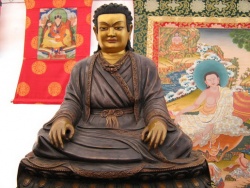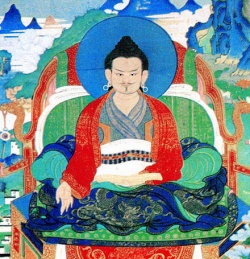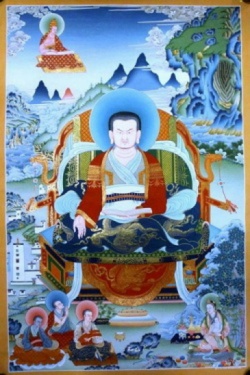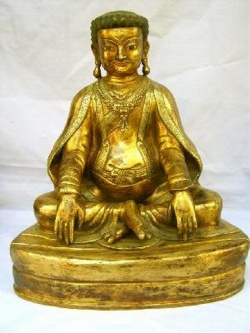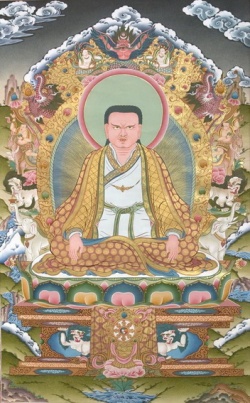Difference between revisions of "Marpa Chokyi Lodro"
| Line 1: | Line 1: | ||
[[File:Marpa 112.jpg|thumb|250px|]] | [[File:Marpa 112.jpg|thumb|250px|]] | ||
| − | '''[[Marpa Chokyi Lodro]]''' (''[[mar pa chos kyi blo gros]]'') was born around 1012 in Chukhyer (Chu khyer) in the [[Lhodrak]] (lho brag) region of southern [[Tibet]]. His father was [[Marpa | + | '''[[Marpa Chokyi Lodro]]''' (''[[mar pa chos kyi blo gros]]'') was born around 1012 in Chukhyer (Chu khyer) in the [[Lhodrak]] (lho brag) region of southern [[Tibet]]. His father was [[Marpa Wangchuk Ozer]] ([[mar pa dbang phyug 'od zer]]), and his mother was [[Gyamo Ozer]] ([[rgya mo 'od zer]]). The youngest of four siblings, as a boy, he showed a great aptitude for [[languages]], {{Wiki|learning}} to read and write at a young age under the tutelage of a [[master]] known as [[Lugye]] ([[klu brgyad]]). |
He was also an insolent and short-tempered youth, so at the age of fifteen his [[parents]] sent him to study with the acclaimed [[scholar]] [[Drokmi Śākya Yeshe]] ([['brog mi lo tsA wa shAkya ye shes]], c.992-c.1072) at the latter’s [[hermitage]] in [[Mangkhar Mugu Lung]] ([[mang mkhar mu gu lung]]). [[Marpa]] studied [[Sanskrit]] and [[Indian]] vernacular [[languages]] under [[Drokmi Lotsāwa]]’s [[direction]] for three years, but could not afford to pay the high fees his [[teacher]] charged for [[initiation]] and [[dharma]] instruction. This led [[Marpa]] to seek the [[dharma]] from other [[teachers]] by traveling [[south]] to [[Nepal]] and [[India]]. To that end he joined the company of [[Nyo Lotsāwa]] ([[gnyos lo tsA ba]]), whom he attended as a servant on their way to [[Nepal]]. | He was also an insolent and short-tempered youth, so at the age of fifteen his [[parents]] sent him to study with the acclaimed [[scholar]] [[Drokmi Śākya Yeshe]] ([['brog mi lo tsA wa shAkya ye shes]], c.992-c.1072) at the latter’s [[hermitage]] in [[Mangkhar Mugu Lung]] ([[mang mkhar mu gu lung]]). [[Marpa]] studied [[Sanskrit]] and [[Indian]] vernacular [[languages]] under [[Drokmi Lotsāwa]]’s [[direction]] for three years, but could not afford to pay the high fees his [[teacher]] charged for [[initiation]] and [[dharma]] instruction. This led [[Marpa]] to seek the [[dharma]] from other [[teachers]] by traveling [[south]] to [[Nepal]] and [[India]]. To that end he joined the company of [[Nyo Lotsāwa]] ([[gnyos lo tsA ba]]), whom he attended as a servant on their way to [[Nepal]]. | ||
Latest revision as of 12:53, 14 December 2013
Marpa Chokyi Lodro (mar pa chos kyi blo gros) was born around 1012 in Chukhyer (Chu khyer) in the Lhodrak (lho brag) region of southern Tibet. His father was Marpa Wangchuk Ozer (mar pa dbang phyug 'od zer), and his mother was Gyamo Ozer (rgya mo 'od zer). The youngest of four siblings, as a boy, he showed a great aptitude for languages, learning to read and write at a young age under the tutelage of a master known as Lugye (klu brgyad).
He was also an insolent and short-tempered youth, so at the age of fifteen his parents sent him to study with the acclaimed scholar Drokmi Śākya Yeshe ('brog mi lo tsA wa shAkya ye shes, c.992-c.1072) at the latter’s hermitage in Mangkhar Mugu Lung (mang mkhar mu gu lung). Marpa studied Sanskrit and Indian vernacular languages under Drokmi Lotsāwa’s direction for three years, but could not afford to pay the high fees his teacher charged for initiation and dharma instruction. This led Marpa to seek the dharma from other teachers by traveling south to Nepal and India. To that end he joined the company of Nyo Lotsāwa (gnyos lo tsA ba), whom he attended as a servant on their way to Nepal.
In the Kathmandu Valley, Marpa encountered a large gaṇacakra ritual feast officiated by the Nepalese teachers Chitherpa and Paiṇḍapa, both disciples of the great Bengali adept Nāropa. From Chitherpa, he received the oral instruction on the Catuḥpīṭha Tantra and the practice of Ejection of Consciousness ('pho ba), as well as the initiation of the goddess Vetālī. He continued his study of Sanskrit with Paiṇḍapa. These teachers encouraged Marpa to travel to India in order to meet Nāropa, who would become his principal guru. On their advice he first spent three years in Nepal, living at the Buddhist site of Swayambhū, in order to acclimate to the lowland heat. Chitherpa and Paiṇḍapa gave Marpa a letter addressed to Nāropa’s disciple Prajñāsiṃha, requesting an introduction to the great Bengali adept.
Once again accompanying Nyo Lotsāwa, Marpa journeyed to India and eventually reached the great center of Buddhist learning Nālānda. Upon learning that Nāropa was instead dwelling at the forest retreat of Pullahari, Nyo attempted to discourage Marpa from seeking out a master who had abandoned scholarship for yogic practice. Undeterred, Marpa travelled to Pullahari where he met Nāropa and received a series of tantric initiations and instructions. These primarily consisted of the mother and father classes of Highest Yoga Tantra, with the Hevajra Tantra and Guhyasamāja Tantra foremost among them. During this period in India Marpa also studied with the paṇḍita Jñānagarbha in Lakṣetra and the adept Kukkuripa. He further trained under great adept Maitrīpa, from whom he received instructions on Mahāmudrā and the tradition of dohā songs of spiritual realization.
After twelve years away, Marpa returned to Tibet once again accompanied by Nyo Lotsāwa. Local customs tax officials detained him at the border between Nepal and Tibet during which time he had a visionary dream of the great Indian adept Saraha, who imparted transmissions of Mahāmudrā. Marpa eventually reached his homeland in Lhodrak. He began to teach but soon desired to return to India. In order to find sponsors for the journey and obtain provisions necessary for the trip, he travelled the countryside giving dharma instruction in exchange for gold and other gifts. It was during this time that he met two of his chief disciples Ngokton Chokyi Dorje (rngog ston chos kyi rdo rje, 1036-1097) and Tsurton Wangi Dorje (mtshur ston dbang gi rdo rje, d.u.). As Marpa’s fame grew, he gained both a large following and great wealth. He established a home and teaching center in Trowolung (bro bo lung) and married Dakmema (bdag med ma), who gave birth to Marpa’s son Darma Dode (dar ma mdo sde). (He is said to have had nine wives and seven sons altogether.)
Marpa then undertook his second journey to India, where he once again received instructions from Nāropa, Maitrīpa, Kukkuripa, and other teachers. As he was preparing to leave, Nāropa commanded that he come back to India once more to receive a final set of instructions. After six year away, Marpa returned to Tibet, where he settled into a life as both lay landholder and Buddhist teacher. He continued to transmit the initiations and instructions he received. Most famous among these were the elaborate system of tantric rituals and meditation practices known as the Naro Chodruk (na ro chos drug; the Six Doctrines of Nāropa), and the tradition of Mahāmudrā. Both became important Kagyu practices and were also transmitted to other Tibetan Buddhist schools. At Trowolung, Marpa met his disciples Meton Tsonpo Sonam Gyeltsen (mes ston tshon po bsod nams rgyal mtshan, d.u.) and the most famous of his four religious sons Milarepa (mi la ras pa, c. 1040-1123). It was during this period that Marpa famously trained Milarepa by commanding him to construct a nine-storied tower for his son Darma Dode.
Although Marpa had planned to transmit his dharma lineage to his son, Darma Dode died at a young age. According to tradition, the boy returned as the Indian Brahmin Pārāvatapāda or Tiphupa (ti phu pa), who became an important figure in the aural transmission lineage of the Nine Cycles of the Formless Ḍākinīs (lus med mkha' 'gro skor dgu) passed down through Milarepa.
In order to keep his vow to Nāropa, and encouraged by a prophetic dream of Milarepa, Marpa departed on a third trip to India, encountering the acclaimed Indian scholar Atisha Dīpaṃkara Śrījñāna (982-1054) along the way. When he reached India, Marpa learned that Nāropa had “entered the activity” (spyod pa la gshegs pa) of a wandering yogin. Marpa undertook an exhausting search for his guru that lasted many months. After a series of visionary experiences, he finally succeeded in finding Nāropa, who then imparted a series of instructions on the aural transmissions, or nyengyu (snyan brgyud) of Cakrasaṃvara. Nāropa further commanded that these teachings be transmitted to a single disciple each generation, beginning with Milarepa. After three years away, Marpa again returned home.
Although much conflicting information exists about Marpa’s dates, he is said to have passed away in a state of meditation at the age of eighty-eight. After his death, Marpa’s disciple Ngokton preserved the corpse in a stūpa constructed at his residence in Shung. According to his most famous biography, Marpa had thirteen gurus: Nāropa, Maitrīpa, Śāntibhadra, Jñānagarbha, the "yoginī adorned with bone ornaments," Kasoripa, Riripa, Jetaripa, Prajñārakṣita, Chitherpa, Paiṇḍapa, and Atisha. Some western scholars have identified “the yoginī adorned with bone ornaments” with the female teacher Niguma although most Tibetan sources do not support this identification. Some twenty-four works translated from Sanskrit attributed to Marpa are preserved in the Tibetan Buddhist canon.
Sources
A mgon rin po che. 2004. Rje btsun mar pa'i rnam thar. In 'Bri gung bka' brgyud chos mdzod chen mo, vol. 46, pp. 117-193. Lhasa. TBRC W00JW501203.
Anon. 1970 (1771). Sgra bsgyur chen po mar pa'i rnam par thar pa. In 'Ba' ra bka' brgyud gser 'phreng chen mo, vol. 1, pp. 149-202. Dehra Dun: Ngawang gyeltsen and ngawang lungtok. TBRC W19231.
Anon. 1975-1978 (1771). Sgra bsgyur mar pa lo ts+tsha'i rnam par thar pa. In Rwa lung dkar brgyud gser 'phreng, vol. 1, pp. 137-166. Sansal: Pelpung sungrab nyamso khang.
Bacot, Jacques. 1937. La vie de Marpa le traducteur: suivie d'un chapitre de l'Avandana de l'oiseau Nilakantha. Paris: Paul Geuthner.
Bde chen rdo rje. 1973. Skyes mchog mar pa lo tsA'i thar. In Dkar brgyud gser 'phreng, pp. 137-188. Sansal: Pelpung sungrab nyamso khang. TBRC W23436.
Bsod nams rgya mtsho. N.d. Mnga' bdag mar pa lo tsA'i rnam thar. In Bka' brgyud chos 'byung nor bu'i phreng ba, vol. 1, pp. 15-17. TBRC W1KG4232.
Bsod nams rin chen. 1976. Rje mar pa dang rje btsun mi la'i rnam thar. In Gsung 'bum / sgam po pa, vol. 1, pp. 16-26. Delhi: Shashin. TBRC W23444. See also TBRC W23439
Chos grags ye shes. 2009. Mnga' bdag lo tsA ba chen po'i bstod pa dad pa'i 'brug sgra sogs. In Gsung 'bum / chos grags ye shes, vol. 4, 161-165. Beijing: Krung go'i bod rig pa dpe skrun khang. TBRC W1KG4876.
Chos kyi 'byung gnas. 1990. Lho brag mar pa lo tsA ba chos kyi blo bros. In Gsung 'bum / chos kyi 'byung gnas, vol. 11, pp. 55-63. Sansal: Pelpung sungrab nyamso khang. TBRC W26630.
Davidson, Ronald M. 2005. Tibetan Renaissance: Tantric Buddhism in the Rebirth of Tibetan Culture. New York: Columbia University Press.
Decleer, Hubert. 2004. “Mar pa.” In Lindsay Jones, ed., Encyclopedia of Religion. Second edition. New York: Macmillan Reference, pp. 5715-5716.
Dpa' bo gtsug lag phreng ba. 2010 (1563). Rje btsun mar pa'i rnam par thar pa grub pa'i ngo mtshar brjod pa. Varanasi: Bi dyA dpe mdzod khang.
Gtsang smyon he ru ka. 1970. Sgra bsgyur mar pa lo tsA'i rnam par thar pa mthong ba don yod. Varanasi: E. Kalsang.
Gtsang smyon he ru ka rus pa'i rgyan can. 2004. Mar pa'i rnam thar mthong ba don yod. In 'Bri gung bka' brgyud chos mdzod chen mo, vol. 6, pp. 291-526. Lhasa. TBRC W00JW501203.
'Jam dbyangs chos kyi blo gros. 1981. Mnga' bdag mar pa lo tsA'i bla ma'i rnal 'byor. In Gsung 'bum / 'jam dbyangs chos kyi blo gros, vol. 1, pp. 431-433. Gangtok: Dzongsar khyentse labrang. TBRC W21813.
Khu byug. 2004. Mar pas mai tri pa las klu sgrub dang zla ba'i dgongs bzhed tshul bzhin du zhus pa. In Bod kyi dbu ma'i lta ba'i 'chad nyan dar tshul blo gsal mig 'byed, pp. 11-29. Beijing: Krung go'i bod rig pa dpe skrun khang. TBRC W28813.
Mi nyag mgon po et. al. 1996. Mar pa lo tsA ba chos kyi blo gros kyi rnam thar mdor bsdus. In Gangs can mkhas dbang rim byon gyi rnam thar mdor bsdus, vol. 2, pp. 14-16. Beijing: Krung go'i bod kyi shes rig dpe skrun khang. TBRC W25268.
Mkha' spyod dbang po. 14th. c. Mar pa'i rnam thar gsang ba mdzod kyi lde mig. W2CZ7978.
Nālandā Translation Committee, tr. 1986. The Life of Marpa the Translator. Boston: Shambhala Publications.
Pad+ma 'phrin las snying po and Karma bde chen. 2010. Mar mi dwags gsum gyi bla ma'i rnal 'byor thig le skor gsum gyi sngon rjes kyi spyi chings rdo rje'i drwa ba. In Gsung 'bum / pad+ma 'phrin las snying po, vol. 1, pp. 272-279. Chengdu: Gzu dgon rig gzhung nyams gso khang. TBRC W1KG5787.
'Phrin las rgya mtsho . 2009. Chos kyi blo gros kyi rnam thar. In Bla ma brgyud pa'i rnam thar ngo mtshar zla ba'i me long, vol. 1, pp. 53-75. Plouray: Drukpa plouray.
Phun tshogs tshe ring. 2003. Sgrub brgyud bstan pa'i bdag po mar pa lo tsA'i skor. In Chos 'byung mkhas pa'i dgongs rgyan, pp. 138-142. Lhasa: Bod ljongs mi dmangs dpe skrun khang. TBRC W25995.
Quintman, Andrew, tr. 2010. The Life of Milarepa. New York: Penguin Classics.
Rin chen dpal. 1972. Mar pa chos kyi blo gros kyi rnam thar. In Bka' brgyud yid bzhin nor bu yi 'phreng ba, vol. 106-174. Leh: S.W. Tashigangpa. TBRC W23181.
Roerich, George N. 1976. The Blue Annals. 2d ed. Delhi: Motilal Banarsidass.
Tshe dbang rgyal. 1994. Dam paʼi chos kyi byung baʼi legs bshad Lho-rong chos ʼbyung ngam Rta tshag chos ʼbyuṅ zhes rtsom paʼi yul ming du chags paʼi ngo mtshar zhing dkon paʼi dpe khyad par can bzhugs so. Lhasa: Bod ljongs Bod yig Dpe rnying Dpe skrun khang.
Wylie, Turrell. "Marpa's Tower: Notes on Local Hegemons in Tibet." History of Religions 3 (1964): 278-91.
Ye shes chos dar. 1972. Mar pa lo tsA'i rnam thar. In Dwags po bka' brgyud kyi ring lugs dri ma med pa'i tshul cung zad gleng ba, pp. 11-29. Varanasi: Wa na legs bshad gter mdzod khang. TBRC W00KG09748.
Source
The following biography is from the Treasury of Lives, a biographical encyclopedia of Tibet, Inner Asia and the Himalaya. The biography is written by Andrew Quintman.
www.treasuryoflives.org
